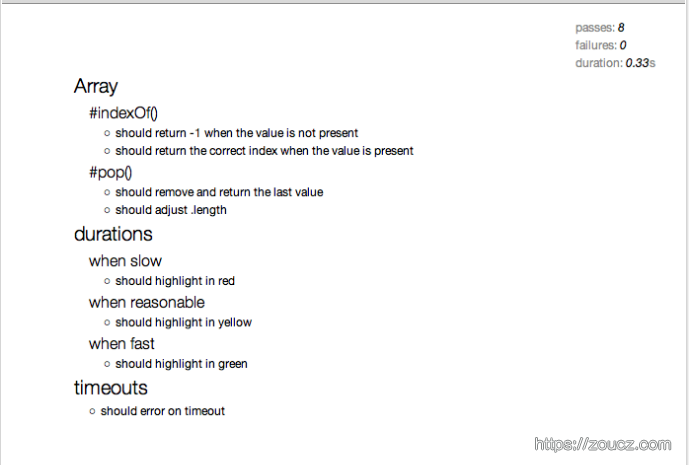javascript单元测试框架mochajs详解
关于单元测试的想法
对于一些比较重要的项目,每次更新代码之后总是要自己测好久,担心一旦上线出了问题影响的服务太多,此时就希望能有一个比较规范的测试流程。在github上看到牛逼的javascript开源项目,也都是有测试代码的,看来业界大牛们都比较注重单元测试这块。就我自己的理解而言:?我要说话
- 涉及到大量业务逻辑的代码,可能我没有精力去给每个函数都写上单元测试的代码,功能细节的测试应该交由测试的同事去完成,但是对会直接影响项目正常运行的重要的数据接口,还是可以看情况写上几个单元测试用例的,每一次修改之后跑一跑用例测试一下。
- 重要的框架底层模块,任何地方出一个小问题,都可能影响到很多服务。对于这种模块,最好是每个函数、每种接口都写上单元测试代码,不然一出问题就是一个大坑啊。
- 开放出去的公共模块,可以针对主要的函数和接口写上单元测试代码,这样可以确保模块代码比较健壮,看起来也专业一些:)。
基于以上几个想法,我决定学习一款Javascript单元测试框架,并试试去使用它写一些单元测试的代码。看了很多技术站点和博客的文章,参考了一部分开源项目的测试代码,大致观望下风向,决定学习一下mocha.js这款单元测试框架。别人的文章都是别人自己学习、咀嚼理解出来的内容,想学的透彻一点,还是自己学习并翻译一遍原版官方的文档比较好。?我要说话
mocha单元测试框架简介
mocha是一款功能丰富的javascript单元测试框架,它既可以运行在nodejs环境中,也可以运行在浏览器环境中。javascript是一门单线程语言,最显著的特点就是有很多异步执行。同步代码的测试比较简单,直接判断函数的返回值是否符合预期就行了,而异步的函数,就需要测试框架支持回调、promise或其他的方式来判断测试结果的正确性了。mocha可以良好的支持javascript异步的单元测试。mocha会串行地执行我们编写的测试用例,可以在将未捕获异常指向对应用例的同时,保证输出灵活准确的测试结果报告。?我要说话
安装mocha
npm install mocha -g?我要说话
一个简单的例子
全局安装mocha后,在项目根目录创建test目录编写test01.js ,?我要说话
1 2 3 4 5 6 7 8 9 |
var assert = require('chai').assert; describe('Array', function() { describe('#indexOf()', function() { it('should return -1 when the value is not present', function() { assert.equal(-1, [1,2,3].indexOf(5)); assert.equal(-1, [1,2,3].indexOf(0)); }); }); }); |
?我要说话
npm install chai --save 安装一下官方文档中使用的chai断言模块(一个用来判断结果是否正确的模块)打开控制台,在test目录同级运行mocha,得到如下结果: Array?我要说话
#indexOf()
√ should return -1 when the value is not present
1 passing (11ms)
可以看到:describe函数的第一个参数会被输出在控制台中,作为一个用例集的描述,而且这个描述是可以根据自己的需求来嵌套输出的,下面称之为:用例集定义函数。it函数第一个参数用来输出一个用例的描述,前边打个对勾代表测试通过,第二个参数是一个函数,用来编写用例内容,用断言模块来判断结果的正确性,下面称之为用例函数。?我要说话
mocha支持的断言模块
mocha支持任何可以抛出一个错误的断言模块。例如:should.js、better-assert、expect.js、unexpected、chai等。这些断言库各有各的特点,大家可以了解一下它们的特点,根据使用场景来选择断言库。?我要说话
同步代码测试
在测试同步代码的时候,用例函数执行完毕后,mocha就直接开始执行下一个用例函数了。 下面是一个同步测试代码的例子:?我要说话
1 2 3 4 5 6 7 8 |
describe('Array', function() { describe('#indexOf()', function() { it('should return -1 when the value is not present', function() { [1,2,3].indexOf(5).should.equal(-1); [1,2,3].indexOf(0).should.equal(-1); }); }); }); |
?我要说话
异步代码测试
官方文档自称,用mocha来测试异步的代码不要再简单!真的很自信啊~~只需要在用例函数里边加一个done回调,异步代码执行完毕后调用一下done,就可以通知mocha,我执行完啦,去执行下一个用例函数吧!就像下面这样:?我要说话
1 2 3 4 5 6 7 8 9 10 11 |
describe('User', function() { describe('#save()', function() { it('should save without error', function(done) { var user = new User('Luna'); user.save(function(err) { if (err) throw err; done(); }); }); }); }); |
?我要说话
对于上面的情况,判断用例执行成功与否是在异步代码的回调里边完成的,这种情况适用于正确性判断比较复杂的情况。如果异步代码中逻辑错误时,会在回调中抛出一个错误,那么测试代码还可以再简单一点:?我要说话
1 2 3 4 5 6 7 8 9 10 11 |
describe('User', function() { describe('#save()', function() { it('should save without error', function(done) { var user = new User('Luna'); user.save(function(err) { if (err) throw err; done(); }); }); }); }); |
?我要说话
promise代码测试
如果异步模块并不是使用callback,而是使用promise来返回结果的时候,可以让用例函数返回一个promise对象来进行正确性判断,像下面这样:?我要说话
1 2 3 4 5 6 7 8 9 10 11 12 |
beforeEach(function() { return db.clear() .then(function() { return db.save([tobi, loki, jane]); }); }); describe('#find()', function() { it('respond with matching records', function() { return db.find({ type: 'User' }).should.eventually.have.length(3); }); }); |
?我要说话
后边还会再提到这种情况?我要说话
不建议使用箭头函数
不建议在mocha测试框架中使用箭头函数。箭头函数语法中对this的绑定让会用例函数没办法访问Mocha框架上下文中定义的一些函数,例如this.timeout(1000)在箭头函数中就无法得到正确的结果。我对这里的理解是:mocha会把用例函数注册到自身的某个属性中,通过属性调用的使用,正常函数可以访问到mocha的其他属性,但是箭头函数不行,就像下面的代码一样:?我要说话
1 2 3 4 5 6 7 8 9 10 11 12 13 14 15 16 |
function getTest(){ this.a=555; var test={ a:1, b:function(){ console.log(this.a) }, c:()=>{ console.log(this.a); } } return test; } var test=getTest(); test.b(); test.c(); |
?我要说话
输出结果是 1 555?我要说话
钩子函数
mocha提供4种钩子函数:before()、after()、beforeEach()、afterEach(),这些钩子函数可以用来在用例集/用例函数开始执行之前/结束执行之后,进行一些环境准备或者环境清理的工作。?我要说话
1 2 3 4 5 6 7 8 9 10 11 12 13 14 15 16 17 18 19 20 |
describe('hooks', function() { before(function() { // runs before all tests in this block }); after(function() { // runs after all tests in this block }); beforeEach(function() { // runs before each test in this block }); afterEach(function() { // runs after each test in this block }); // test cases }); |
?我要说话
钩子函数的描述参数
定义钩子函数的时候,可以传第一个可选参数作为钩子函数的描述,可以帮助定位用例中的错误信息。若没有穿第一个参数,使用一个非匿名函数作为钩子函数,那么函数名称就将被作为钩子函数的描述。?我要说话
1 2 3 4 5 6 7 8 9 10 11 |
beforeEach(function() { // beforeEach hook }); beforeEach(function namedFun() { // beforeEach:namedFun }); beforeEach('some description', function() { // beforeEach:some description }); |
?我要说话
异步的钩子函数
钩子函数不仅能是同步函数,也可能是异步的函数,就像前边的异步测试用例函数一样。如果我们在开始之前,需要做一些异步的操作,例如在数据库里边准备一些模拟数据,就需要用到这种场景了:?我要说话
1 2 3 4 5 6 7 8 9 10 11 12 13 14 15 16 17 18 19 20 21 22 23 |
describe('Connection', function() { var db = new Connection, tobi = new User('tobi'), loki = new User('loki'), jane = new User('jane'); beforeEach(function(done) { db.clear(function(err) { if (err) return done(err); db.save([tobi, loki, jane], done); }); }); describe('#find()', function() { it('respond with matching records', function(done) { db.find({type: 'User'}, function(err, res) { if (err) return done(err); res.should.have.length(3); done(); }); }); }); }); |
?我要说话
全局钩子
前边讲的钩子函数都是定义在用例集函数里边的,如果在用例集函数之外定义钩子函数,那么这个钩子函数将会对所有的mocha单元测试用例生效。若编写了多个用例集js文件,无论在哪一个用例集文件中,用例集函数之外定义钩子函数,都会对所有用例函数生效。前边讲到,用例集函数是可以嵌套的,而mocha会生成一个包在最外面的describe函数,把所有的用例集包含起来,那么在其中定义的钩子函数也就对所有的用例函数生效了~?我要说话
1 2 3 |
beforeEach(function() { console.log('before every test in every file'); }); |
?我要说话
延迟启动测试
如果想在mocha命令运行之后,先做一些别的工作,再启动测试,可以使用mocha --delay命令,此命令会在全局环境中生成一个run函数,延迟工作完成后调用run函数即可启动测试。?我要说话
1 2 3 4 5 6 7 8 9 |
setTimeout(function() { // do some setup describe('my suite', function() { // ... }); run(); }, 5000); |
?我要说话
测试用例TODO
可以编写一个等待被实现的测试用例,在报告里边也会有提示?我要说话
1 2 3 4 5 6 |
describe('Array', function() { describe('#indexOf()', function() { // pending test below it('should return -1 when the value is not present'); }); }); |
?我要说话
2 passing (11ms)
1 pending
仅执行一个用例集/用例
在用例集函数或者用例函数后边添加.only()可以让mocha只执行此用例集或用例?我要说话
1 2 3 4 5 |
describe('Array', function() { describe.only('#indexOf()', function() { // ... }); }); |
?我要说话
Array用例集下面的嵌套集合,只有#indexOf用例集会被执行?我要说话
1 2 3 4 5 6 7 8 9 10 11 |
describe('Array', function() { describe('#indexOf()', function() { it.only('should return -1 unless present', function() { // ... }); it('should return the index when present', function() { // ... }); }); }); |
?我要说话
这种写法,#indexOf用例集下面的用例,只有第一个加了only的会被执行。注意:在同一用例集下有多个only标记,mocha会报错。?我要说话
跳过哪些用例集/用例
和加上.only相反,在用例集函数或者用例函数后边加.skip(),可以跳过此用例集或用例的执行。跳过的用例会被标记为pending的用例,在报告中也会作为pending用例体现出来。下面是一些例子:?我要说话
1 2 3 4 5 |
describe('Array', function() { describe.skip('#indexOf()', function() { // ... }); }); |
?我要说话
跳过用例集?我要说话
1 2 3 4 5 6 7 8 9 10 11 |
describe('Array', function() { describe('#indexOf()', function() { it.skip('should return -1 unless present', function() { // ... }); it('should return the index when present', function() { // ... }); }); }); |
?我要说话
跳过用例。对于一些作废的用例,按我们以往的做法可能就是把它注释掉,mocha推荐的做法是给它们加上skip标记。?我要说话
除了使用添加skip标记之外,mocha还允许在用例执行的过程中跳过此用例,例如用例执行需要某些上下文环境,但是执行的时候发现这些环境并没有准备好,此时就可以调用skip函数跳过此用例:?我要说话
1 2 3 4 5 6 7 |
it('should only test in the correct environment', function() { if (/* check test environment */) { // make assertions } else { this.skip(); } }); |
?我要说话
上面被跳过的用例同样会在测试报告中以pending的形式体现出来。为了避免测试逻辑混乱,在调用skip函数之后,就不要再再用例函数或after钩子中执行更多的逻辑了。?我要说话
这里要说明一点,在一个用例函数中,不要存在一个逻辑分支啥也不做,直接让整个用例函数结束,这样是不科学的。用例函数中应该至少使用断言做一个判断,或者调用skip函数跳过用例。?我要说话
1 2 3 4 5 6 7 |
it('should only test in the correct environment', function() { if (/* check test environment */) { // make assertions } else { // do nothing } }); |
?我要说话
这样的用例如果走到了do nothing逻辑,在报告中会被标记为pass。比较推荐的做法是,在before钩子函数中检查测试需要的上下文环境,不具备则跳过。?我要说话
1 2 3 4 5 6 7 |
before(function() { if (/* check test environment */) { // setup code } else { this.skip(); } }); |
?我要说话
重新执行用例
你可以指定让一个失败的用例重新执行一定次数。这个特性是为做end-to-end测试(功能性测试/Selenium测试)而设计的,这些测试数据不好模拟。 mocha是不推荐用这个特性来做单元测试的。?我要说话
这个特性会重新运行用例函数的beforeEach和afterEach钩子函数,但是不会重新运行before和after钩子函数。?我要说话
下面是一个重新执行的例子:?我要说话
1 2 3 4 5 6 7 8 9 10 11 12 13 14 |
describe('retries', function() { // Retry all tests in this suite up to 4 times this.retries(4); beforeEach(function () { browser.get('http://www.yahoo.com'); }); it('should succeed on the 3rd try', function () { // Specify this test to only retry up to 2 times this.retries(2); expect($('.foo').isDisplayed()).to.eventually.be.true; }); }); |
?我要说话
动态生成用例
mocha可以使用Function.prototype.call和函数表达式来定义用例集和用例,它们可以用来直接动态生成一些测试用例,而不需要使用其他额外的语法。和你可能在其他框架中见到的一样,这个特性可以实现通过定义一些参数来实现测试用例的功能。?我要说话
1 2 3 4 5 6 7 8 9 10 11 12 13 14 15 16 17 18 19 20 21 22 |
var assert = require('chai').assert; function add() { return Array.prototype.slice.call(arguments).reduce(function(prev, curr) { return prev + curr; }, 0); } describe('add()', function() { var tests = [ {args: [1, 2], expected: 3}, {args: [1, 2, 3], expected: 6}, {args: [1, 2, 3, 4], expected: 10} ]; tests.forEach(function(test) { it('correctly adds ' + test.args.length + ' args', function() { var res = add.apply(null, test.args); assert.equal(res, test.expected); }); }); }); |
?我要说话
上面的测试会生成下面这样报告: add() ? correctly adds 2 args ? correctly adds 3 args ? correctly adds 4 args?我要说话
测试时间
许多测试报告会展示测试时间,同样也会标记出那些用例耗时比较长:?我要说话
可能对于某些测试用例,耗时就是会比较长,那么耗费多长时间才应该本认为执行耗时过长呢? 可以通过slow()函数来标记一下:?我要说话
1 2 3 4 5 6 7 |
describe('something slow', function() { this.slow(10000); it('should take long enough for me to go make a sandwich', function() { // ... }); }); |
?我要说话
测试超时
用例集执行超时
在用例集下定义的timeout超时会对此用例集下定义的所有嵌套的用例集和用例生效,如果嵌套的用例集或者用例重写了timeout时间,则会覆盖上层的设置。通过this.timeout(0),可以关掉用例或用例集的超时判断。?我要说话
1 2 3 4 5 6 7 8 9 10 11 |
describe('a suite of tests', function() { this.timeout(500); it('should take less than 500ms', function(done){ setTimeout(done, 300); }); it('should take less than 500ms as well', function(done){ setTimeout(done, 250); }); }) |
?我要说话
用例执行超时
1 2 3 4 |
it('should take less than 500ms', function(done){ this.timeout(500); setTimeout(done, 300); }); |
钩子函数超时
1 2 3 4 5 6 |
describe('a suite of tests', function() { beforeEach(function(done) { this.timeout(3000); // A very long environment setup. setTimeout(done, 2500); }); }); |
钩子函数同样可以通过this.timeout(0)来关闭超时判断。?我要说话
diff差异比较功能
若断言库抛出了AssertionErrors,且错误对象中有err.expected属性和err.actual属性,mocha会尝试在报告中展示期望的值和得到的值的差异:?我要说话
mocha使用命令和参数
mocha init 初始化浏览器中测试
mocha init命令用来生成一个浏览器中单元测试的架子。新建一个目录test在同级目录运行命令 mocha init test ,可以看到test目录下生成了一些样式表文件和js脚本,以及一个用来运行用例、展示报告的index.html接着使用文章开头的chai断言库,此时需要用script标签引入了,于是在index.html中加上?我要说话
1
|
<script src="http://chaijs.com/chai.js"></script>
|
?我要说话
index.html内容如下:?我要说话
1 2 3 4 5 6 7 8 9 10 11 12 13 14 15 16 17 18 19 |
<!DOCTYPE html> <html> <head> <title>Mocha</title> <meta http-equiv="Content-Type" content="text/html; charset=UTF-8"> <meta name="viewport" content="width=device-width, initial-scale=1.0"> <link rel="stylesheet" href="mocha.css" /> </head> <body> <div id="mocha"></div> <script src="http://chaijs.com/chai.js"></script> <script src="mocha.js"></script> <script>mocha.setup('bdd');</script> <script src="tests.js"></script> <script> mocha.run(); </script> </body> </html> |
?我要说话
test.js是一个空文件,等待我们去编写用例,在其中加上:?我要说话
1 2 3 4 5 6 7 8 9 |
var assert = chai.assert; describe('Array', function() { describe('#indexOf()', function() { it('should return -1 when the value is not present', function() { assert.equal(-1, [1,2,3].indexOf(5)); assert.equal(-1, [1,2,3].indexOf(0)); }); }); }); |
?我要说话
在浏览器中打开index.html,可以看到用例执行报告:?我要说话
mocha命令参数
mocha命令的基本格式是:mocha [debug] [options] [files]options包括下面这些,我翻译了一部分目前能理解的?我要说话
1
|
-h, --help 输出帮助信息
-V, --version 输出mucha版本
-A, --async-only 强制让所有测试用例必须使用callback或者返回promise的方式来异步判断正确性
-c, --colors 启用报告中颜色
-C, --no-colors 禁用报告中颜色
-G, --growl enable growl notification support
-O, --reporter-options <k=v,k2=v2,...> reporter-specific options
-R, --reporter <name> specify the reporter to use
-S, --sort 排序测试文件
-b, --bail bail after first test failure
-d, --debug enable node's debugger, synonym for node --debug
-g, --grep <pattern> 只执行满足 <pattern>格式的用例
-f, --fgrep <string> 只执行含有 <string> 的用例
-gc, --expose-gc 展示gc回收的log
-i, --invert 让 --grep 和 --fgrep 的匹配取反
-r, --require <name> require一下<name>指定的模块
-s, --slow <ms> 指定slow时间(单位ms,默认75ms)
-t, --timeout <ms> 指定超时时间(单位ms,默认2000ms)
-u, --ui <name> 指定user-interface (bdd|tdd|exports)
-w, --watch 观察用例文件变化,并重新执行
--check-leaks 检测未回收global变量泄露
--compilers <ext>:<module>,... 用指定的模块来编译文件
--debug-brk 启用node的debug模式
--delay 等待异步的用例集(见前边的)
--es_staging enable all staged features
--full-trace display the full stack trace
--globals <names> allow the given comma-delimited global [names]
--harmony enable all harmony features (except typeof)
--harmony-collections enable harmony collections (sets, maps, and weak maps)
--harmony-generators enable harmony generators
--harmony-proxies enable harmony proxies
--harmony_arrow_functions enable "harmony arrow functions" (iojs)
--harmony_classes enable "harmony classes" (iojs)
--harmony_proxies enable "harmony proxies" (iojs)
--harmony_shipping enable all shipped harmony features (iojs)
--inline-diffs 显示预期和实际结果的string差异比较
--interfaces display available interfaces
--no-deprecation silence deprecation warnings
--no-exit require a clean shutdown of the event loop: mocha will not call process.exit
--no-timeouts 禁用timeout,可通过--debug隐式指定
--opts <path> 定义option文件路径
--prof 显示统计信息
--recursive 包含子目录
--reporters 展示可用报告
--retries 设置失败用例重试次数
--throw-deprecation 每次调用deprecated函数的时候都抛出一个异常
--trace 显示函数调用栈
--trace-deprecation 启用的时候显示调用栈
--watch-extensions <ext>,... --watch监控的扩展
|
?我要说话
下面是官方文档对部分命令的详细说明:?我要说话
-W, –WATCH
用例一旦更新立即执行?我要说话
–COMPILERS
例如--compilers coffee:coffee-script编译CoffeeScript 1.6,或者--compilers coffee:coffee-script/register编译CoffeeScript 1.7+?我要说话
-B, –BAIL
如果只对第一个抛出的异常感兴趣,可以使用此命令。?我要说话
-D, –DEBUG
开启nodejs的debug模式,可以在debugger语句处暂停执行。?我要说话
–GLOBALS
names是一个以逗号分隔的列表,如果你的模块需要暴露出一些全局的变量,可以使用此命令,例如mocha --globals app,YUI。这个命令还可以接受通配符,例如--globals '*bar。参数传入 * 的话,会忽略所有全局变量。?我要说话
–CHECK-LEAKS
默认情况下,mocha并不会去检查应用暴露出来的全局变量,加上这个配置后就会去检查,此时某全局变量如果没有用上面的–GLOBALS去配置为可接受,mocha就会报错?我要说话
-R, –REQUIRE
这个命令可以用来引入一些依赖的模块,比如should.js等,这个命令相当于在测试目录下每个js文件头部运行一下require('should.js'),模块中对Object、Array等对象的扩展会生效,也可以用--require ./test/helper.js这样的命令去引入指定的本地模块。但是… 很鸡肋的是,如果要引用模块导出的对象,还是需要require,var should = require('should')这样搞。?我要说话
-U, –UI
–ui选项可以用来指定所使用的测试接口,默认是“bdd”?我要说话
-R, –REPORTER
这个命令可以用来指定报告格式,默认是“spec”。可以使用第三方的报告样式,例如:npm install mocha-lcov-reporter,--reporter mocha-lcov-reporter?我要说话
-T, –TIMEOUT
用来指定用例超时时间?我要说话
-S, –SLOW
用来指定慢用例判定时间,默认是75ms?我要说话
-G, –GREP
grep pattern可以用来筛选要执行的用例或用例集,pattern参数在mocha内部会被编译成一个正则表达式。假如有下面的测试用例:?我要说话
1 2 3 4 5 6 7 8 9 10 11 12 13 14 15 |
describe('api', function() { describe('GET /api/users', function() { it('respond with an array of users', function() { // ... }); }); }); describe('app', function() { describe('GET /users', function() { it('respond with an array of users', function() { // ... }); }); }); |
?我要说话
可以用--grep api、--grep app、--grep users、--grep GET,来筛选出要执行的用例。?我要说话
测试接口类型
mocha的测试接口类型指的是集中测试用例组织模式的选择,包括BDD行为驱动开发(Behavior Driven Development),TDD测试驱动开发(Test-Driven Development),Exports,QUnit 和 Require-style 几种。?我要说话
BDD
BDD测试接口提供 describe(), context(), it(), specify(), before(), after(), beforeEach(), 和 afterEach()几种函数,其中context函数只是describe函数的别名,specify函数也是if函数的别名。mocha默认的测试接口,前边的所有例子都是基于BDD来编写的。?我要说话
1 2 3 4 5 6 7 8 9 10 11 12 13 14 15 16 17 18 19 20 21 22 23 |
describe('Array', function() { before(function() { // ... }); describe('#indexOf()', function() { context('when not present', function() { it('should not throw an error', function() { (function() { [1,2,3].indexOf(4); }).should.not.throw(); }); it('should return -1', function() { [1,2,3].indexOf(4).should.equal(-1); }); }); context('when present', function() { it('should return the index where the element first appears in the array', function() { [1,2,3].indexOf(3).should.equal(2); }); }); }); }); |
?我要说话
TDD
TDD接口提供 suite(), test(), suiteSetup(), suiteTeardown(), setup(), 和 teardown()函数,用例写法如下:?我要说话
1 2 3 4 5 6 7 8 9 10 11 |
suite('Array', function() { setup(function() { // ... }); suite('#indexOf()', function() { test('should return -1 when not present', function() { assert.equal(-1, [1,2,3].indexOf(4)); }); }); }); |
?我要说话
EXPORTS
Exports 的写法有的类似于Mocha的前身expresso,其写法如下:?我要说话
1 2 3 4 5 6 7 8 9 10 11 12 13 |
module.exports = { before: function() { // ... }, 'Array': { '#indexOf()': { 'should return -1 when not present': function() { [1,2,3].indexOf(4).should.equal(-1); } } } }; |
?我要说话
通过exports导出的对象里边,除了几个钩子函数之外,其他的Object类型属性都是用例集,function类型的属性都是用例。?我要说话
QUNIT
像TDD接口一样支持suite和test函数,同时又像BDD一样支持before(), after(), beforeEach(), 和 afterEach(),等钩子函数。?我要说话
1 2 3 4 5 6 7 8 9 10 11 12 13 14 15 16 17 18 19 20 21 22 23 |
function ok(expr, msg) { if (!expr) throw new Error(msg); } suite('Array'); test('#length', function() { var arr = [1,2,3]; ok(arr.length == 3); }); test('#indexOf()', function() { var arr = [1,2,3]; ok(arr.indexOf(1) == 0); ok(arr.indexOf(2) == 1); ok(arr.indexOf(3) == 2); }); suite('String'); test('#length', function() { ok('foo'.length == 3); }); |
?我要说话
REQUIRE
require测试接口允许你通过require来导入describe函数,取个任意的别名。如果你不希望测试中出现全局的变量,这个接口也是十分有用的。值得注意的是,这里的require不能直接通过node命令来执行,node的模块管理是不能解析这里的require的,需要通过mocha命令来运行。?我要说话
1 2 3 4 5 6 7 8 9 10 11 12 13 14 15 16 |
ar testCase = require('mocha').describe; var pre = require('mocha').before; var assertions = require('mocha').it; var assert = require('chai').assert; testCase('Array', function() { pre(function() { // ... }); testCase('#indexOf()', function() { assertions('should return -1 when not present', function() { assert.equal([1,2,3].indexOf(4), -1); }); }); }); |
?我要说话
测试报告视图
如果不自己加上自定义的报告输出,mocha会在控制台中输出报告。?我要说话
SPEC视图
这个是默认的报告样式,输出一个嵌套的分级视图?我要说话
DOT MATRIX视图
用一系列点点来表示用例,测试的是红点,未实现的是蓝点,比较慢的是黄点,通过的是白点,如果你想让报告看起来简洁一些,可以用这个视图。?我要说话
NYAN视图
尼玛这是个毛线视图啊,官方文档都懒得给出说明?我要说话
TAP视图
?我要说话
LANDING STRIP视图
‘Landing Strip’的意思是飞机降落跑道,这是一个逗逼测试人员弄出来的,像一架飞机降落一样的视图。这个是坠机了的视图……?我要说话
LIST视图
一个简单的列表视图?我要说话
PROGRESS视图
包含一个简单的进度条的视图?我要说话
JSON视图
输出一个JSON作为测试结果?我要说话
##JSON STREAM视图输出的也是一个JSON,只不过输出的时候会带上换行?我要说话
JSONCOV覆盖率报告
一个依赖 node-jscoverage 模块生成的视图,用来生成覆盖率报告?我要说话
HTMLCOV覆盖率报告
用来生成一个覆盖率的html报告https://github.com/expressjs/express/commit/b6ee5fafd0d6c79cf7df5560cb324ebee4fe3a7f?我要说话
MIN视图
只显示总体测试情况?我要说话
DOC视图
生成一个只包含html的body部分的报告,结构如下:例如,测试代码如下:?我要说话
1 2 3 4 5 6 7 8 |
describe('Array', function() { describe('#indexOf()', function() { it('should return -1 when the value is not present', function() { [1,2,3].indexOf(5).should.equal(-1); [1,2,3].indexOf(0).should.equal(-1); }); }); }); |
?我要说话
运行命令mocha --reporter doc array,结果:?我要说话
1 2 3 4 5 6 7 8 9 10 11 12 13 |
<section class="suite"> <h1>Array</h1> <dl> <section class="suite"> <h1>#indexOf()</h1> <dl> <dt>should return -1 when the value is not present</dt> <dd><pre><code>[1,2,3].indexOf(5).should.equal(-1); [1,2,3].indexOf(0).should.equal(-1);</code></pre></dd> </dl> </section> </dl> </section> |
?我要说话
自己添加head、html等标签,再加上style,可以生成自定义样式的报告。?我要说话
MARKDOWN视图
生成一个markdown版本的报告,例子:https://github.com/senchalabs/connect/blob/90a725343c2945aaee637e799b1cd11e065b2bff/tests.md?我要说话
HTML视图
目前只有在浏览器中运行的mocha才能直接生成html报告,nodejs中可以通过doc视图或者markdown视图得到的内容自己用脚本生成html版本的~?我要说话
第三方报告生成器
mocha允许我们自己定义第三方的报告生成器,可以参考文档。一个例子:TeamCity reporter?我要说话
在浏览器中运行mocha
mocha项目下都会有mocha.js和mocha.css供浏览器中的测试使用?我要说话
只能在浏览器中使用的函数
mocha.allowUncaught() ,未捕获的错误不会被抛出下面是一个例子,在加载测试脚本之前,用mocha.setup('bdd')函数把测试模式设置为BDD接口,测试脚本加载完之后用mocha.run()函数来运行测试?我要说话
1 2 3 4 5 6 7 8 9 10 11 12 13 14 15 16 17 18 19 20 21 22 23 24 |
<html> <head> <meta charset="utf-8"> <title>Mocha Tests</title> <link href="https://cdn.rawgit.com/mochajs/mocha/2.2.5/mocha.css" rel="stylesheet" /> </head> <body> <div id="mocha"></div> <script src="https://cdn.rawgit.com/jquery/jquery/2.1.4/dist/jquery.min.js"></script> <script src="https://cdn.rawgit.com/Automattic/expect.js/0.3.1/index.js"></script> <script src="https://cdn.rawgit.com/mochajs/mocha/2.2.5/mocha.js"></script> <script>mocha.setup('bdd')</script> <script src="test.array.js"></script> <script src="test.object.js"></script> <script src="test.xhr.js"></script> <script> mocha.checkLeaks(); mocha.globals(['jQuery']); mocha.run(); </script> </body> </html> |
?我要说话
GREP
浏览器中可以通过在url后边加?grep=api参数,来使用grep命令?我要说话
浏览器中的mocha配置
可以通过mocha.setup()命令来设置配置?我要说话
1 2 3 4 5 6 7 8 9 10 11 12 13 14 15 |
// Use "tdd" interface. This is a shortcut to setting the interface; // any other options must be passed via an object. mocha.setup('tdd'); // This is equivalent to the above. mocha.setup({ ui: 'tdd' }); // Use "tdd" interface, ignore leaks, and force all tests to be asynchronous mocha.setup({ ui: 'tdd', ignoreLeaks: true, asyncOnly: true }); |
?我要说话
浏览器中特有的选项
noHighlighting
如果被设置为true,mocha不会尝试用高亮语法输出测试代码?我要说话
MOCHA.OPTS(mocha配置)
在服务端运行的时候,mocha会去加载test目录下的mocha.opts文件,来读取mocha配置项。这个配置文件中的每一行代表一项配置。如果运行mocha命令的时候,带上的配置参数与这个配置文件中的配置冲突的话,以命令中的为准。例如: –require should –reporter dot –ui bdd上面的配置就会让mocha 引入一下should模块、报告样式设置为dot,并且使用bdd的测试接口。?我要说话
test/ 目录
默认情况下,mocha会去当前路径下的去找 ./test/*.js或者./test/*.coffee当做测试文件,所以测试文件应该放在test目录下?我要说话
编辑器插件
TEXTMATE、JETBRAINS (IntelliJ IDEA, WebStorm, etc.) 等编辑器均有支持mocha测试的插件,需要使用的话请自行查阅。
原文转自: http://www.zoucz.com/blog/2016/08/02/nodejs-unittest-mochajs/





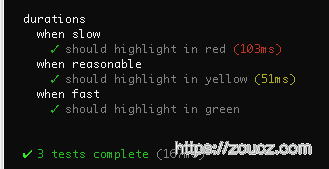
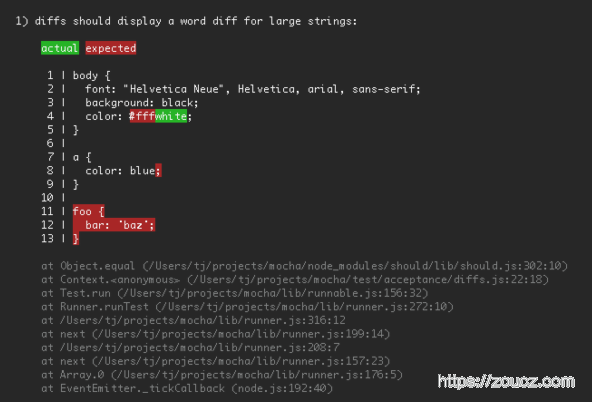
 在同级目录运行命令
在同级目录运行命令  接着使用文章开头的chai断言库,此时需要用script标签引入了,于是在index.html中加上
接着使用文章开头的chai断言库,此时需要用script标签引入了,于是在index.html中加上




 这个是坠机了的视图……
这个是坠机了的视图……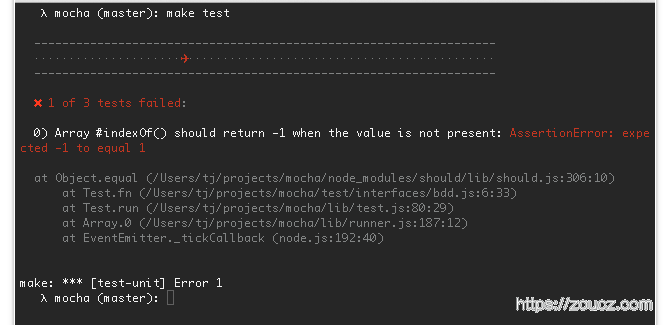

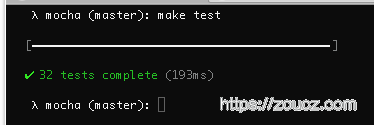
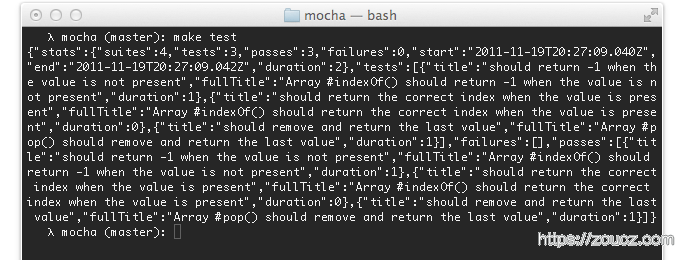


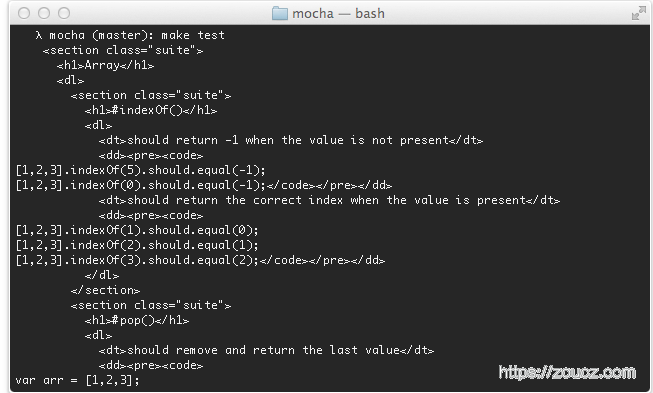 例如,测试代码如下:
例如,测试代码如下: